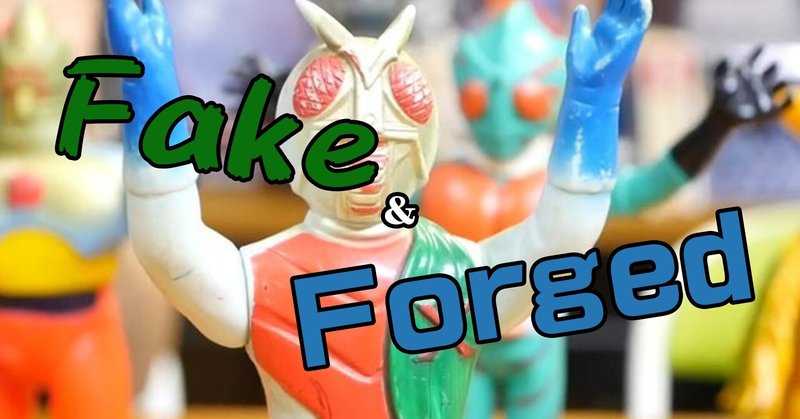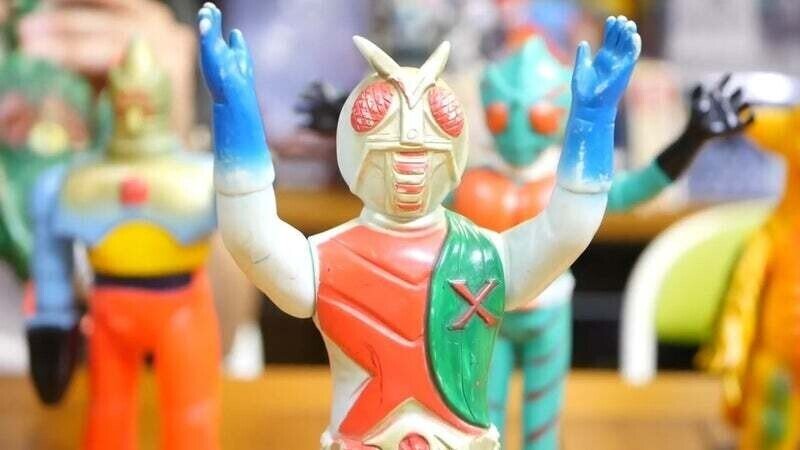
[2: "Pachimono" of SOFUBI] What is a "Pachimono" in the world of SOFUBI?! The difficult line between "fake and "pachimono" (forged stuff). The mysterious and interesting world of SOFUBI.
The world of SOFUBI is mysterious, deep and interesting. In the world of SOFUBI, there are "pachimono", or "fake" and "pachimono", which have two different values. there are also collectors who see an element of art in the "pachimono", and they are priced at a premium. In the past they were fakes, but now they have become outsiders, and there is even an artistic element to them. We would like to talk about the world of "pachimono", the unique world of SOFUBI.
In the first part of the previous article, we compared and tested fake and real
SOFUBI, so please have a look at that too if you like ↓↓↓
And the second one this time is "Pachimono" ("forged stuff"). some of you may be thinking, "What is a pachimono, a fake?" I know some of you may think so, and that's right, it is... However! Unlike other figures and brand-name products, SOFUBI has a world view of "fake" and "pachimono". What do we mean by that? In this article, we'll talk about it.
When it comes to SOFUBI, the difference between the terms "pachimono" and "fake" is a big difference, and this is both the charm and the mystery of SOFUBI.
In the world of SOFUBI, a "pachimono" is not a "fake". This is also interesting.
Strictly speaking, it is "a thing that was once a fake".
Some people found the fakes interesting and fun, evaluated the "pachimono", which was a poor imitation at that time, appeared. I can imagine why such a phenomenon happened, but... I would like to talk about it!
Fakes of that time were not mass-produced, but rather in small quantities, and
the materials used were different between now and then. So even if it is a fake, the material used in the past was different from that used nowadays and the quantity in circulation was small. It's all about quantity and material.
But maybe he was just someone who thought differently, or maybe he wanted to collect one-of-a-kind items that everyone else didn't have, I don't really know.
Therefore, even the "pachimono" at that time can no longer be made and has a rare value, so the price rises secretly among collectors and the "pachimono" gets a premium price.
After all, the market value is priced by collectors, including its rarity.
A fake Kamen Rider!? There's cuteness in it, too! LOL!

It was also mentioned in the "SOFUBI-Do" (SOFUBI-Road), the charm of the
"fluctuation" of retro SOFUBI still applies to the "pachimono", and there is a
part of it that looks attractive. I think that one of the reasons why people are
attracted to retro SOFUBI is that they want to own something that other people don't have, and that the it looks attractive after going around.
They are not satisfied with the retro SOFUBI that you often see in magazines or TV, and they're becoming more attracted to the "pachi-SOFUBI" that makes me laugh unintentionally.
And what's interesting about the "pachimono" at that time is that the design is completely the same as the real thing, but they have an impossible coloring, like "No, it's a different thing!" . But they go like, "This is it!". That is so cute
to look at, doesn't it?
It's kind of "like a kid is lying", sort of. LOL!
In the past, there were probably less restrictions on fakes than there are now.
This may be the reason why they made "pachimono" just for fun with the materials of the time. Of course, there is no copyright because it is a "forged stuff". They were making "Kamen Rider", "Ultraman" and "Ultra Monster" without any permission.
Of course, copyright issues were dealt with at the time, but I don't think the
regulations were as strict as they were for SOFUBI. "Pachi-SOFUBI" was cheap and you could buy it at a candy store. The thing sold at a candy store was obviously "This package must be "that!". There are quite a few gray zone for things like this, and I wonder if SOFUBI was like that, too.
Obviously the paint and construction is a bit of mess, so I guess the original
owner didn't take too kindly to it.
However, it is not the case that all "pachimono" are accepted. Of course, there
are those who think they are fake, but there are also those who think they are
valuable because they are made from materials of that time and has an atmosphere that cannot be created elsewhere. It's up to each collector.

Fake ↑ Real ↑
So,
I think one question arises here.
What is the difference between a forged and a fake, in short, where is the line
drawn? That's what I mean.
This is very difficult, and there is a part that depends on individual values in
the previous story, but since there is no meaning in this video after that, the
difference between "pachimono" and "fake, including your own way of thinking I would like to define.
"Pachimono" (forged stuff)
It is a fake (counterfeit goods) made at that time. The material used at that
time had the atmosphere of Showa Retro at that time, and it was a SOFUBI that was treated as a fake at that time. It is a former fake.
Fake
In the world of SOFUBI, the definition of a fake is, for example, that a genuine
item of the period has received a premium and its market value has risen
dramatically. If a person sees it and knows about it and thinks "this is worth a
lot of money" and makes an imitation, it is called a fake.
In short, a fake is created deliberately to deceive someone "after" seeing a
premium price. That's how we interpret it. So, was the fake created "before" or
"after" with a premium price? That's the question.
Here's the fake and the real SOFUBI we talked about in the last installment. It
is very difficult to reproduce the age-related deterioration of the original and
make it look exactly like the real thing. After all, the "taste" of that time,
such as scratches and color baldness, which naturally grows over the years, can only be produced if it is genuine.
It's a bit out there, but it's beyond the line that isn't a joke.
It's not about personal enjoyment, it's about making copies, cheating people and making money. That's "strike 3".
The story may be a little off, but by favorite retro toy is a vending machine
called "Cosmos", which was also amazingly full of fakes. (Cosmos was a vending machine with toys only. Like Gacha-Gacha, but in a vending machine.)
The toy maker made their own toys and sold them as prizes, but it was in a very grey area. For example, "Dangam" instead of "Gundam", "Choro-Car" instead of "Choro-Q", and so on...
And finally, they copied and sold "BIKKURIMAN stickers", which were very popular among children at that time. The "Lotte" logo on the back was changed to "Lotti" and other designs were copied and sold as they were, so the children went "it's cheating!! It's FAKE!" It was a big problem at that time because "Lotte" company heard about it.
As one of the boundaries, I think there are things that can't be done with a
light joke...
In this way, as we work as a shop specializing in the purchase of SOFUBI and
figures, we would like to send out new discoveries that we make, and in this way, we hope to be able to provide information that is useful as much as possible.
It's like this, how we compare fakes with the real thing and preview rare
products.
[Toy's King Retro Museum!] Retro Toys for Sale on Instagram!
この記事が気に入ったらサポートをしてみませんか?

